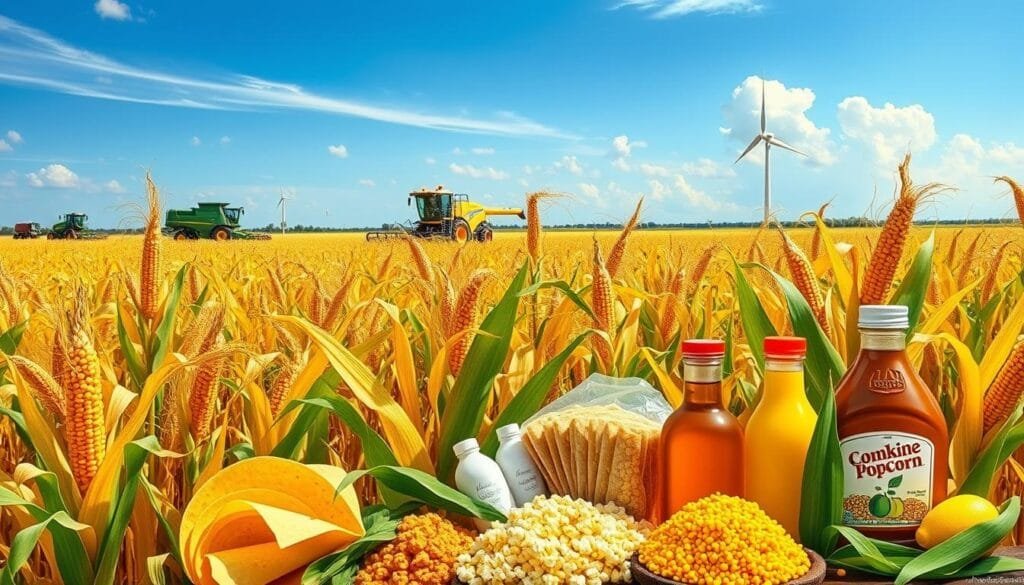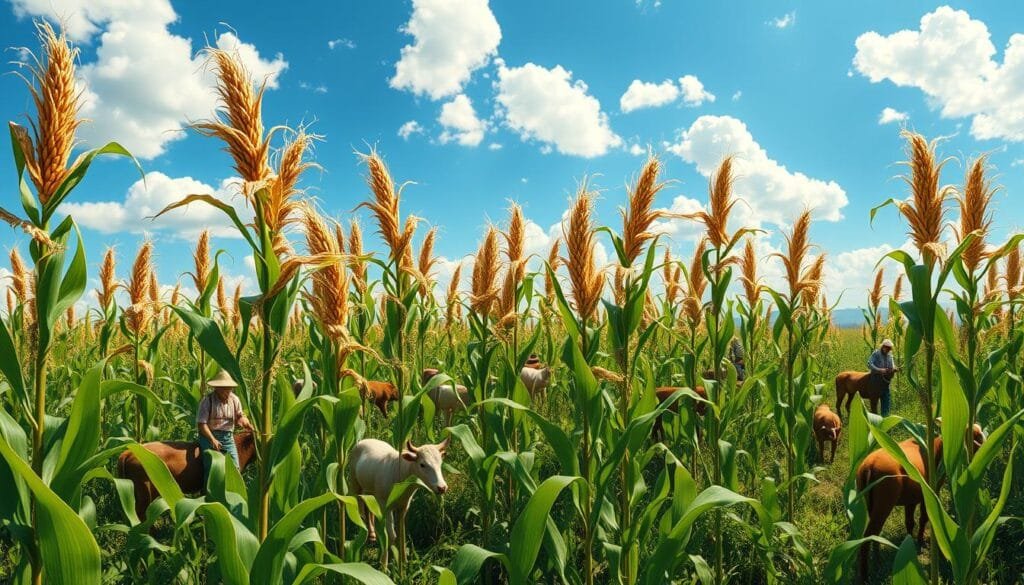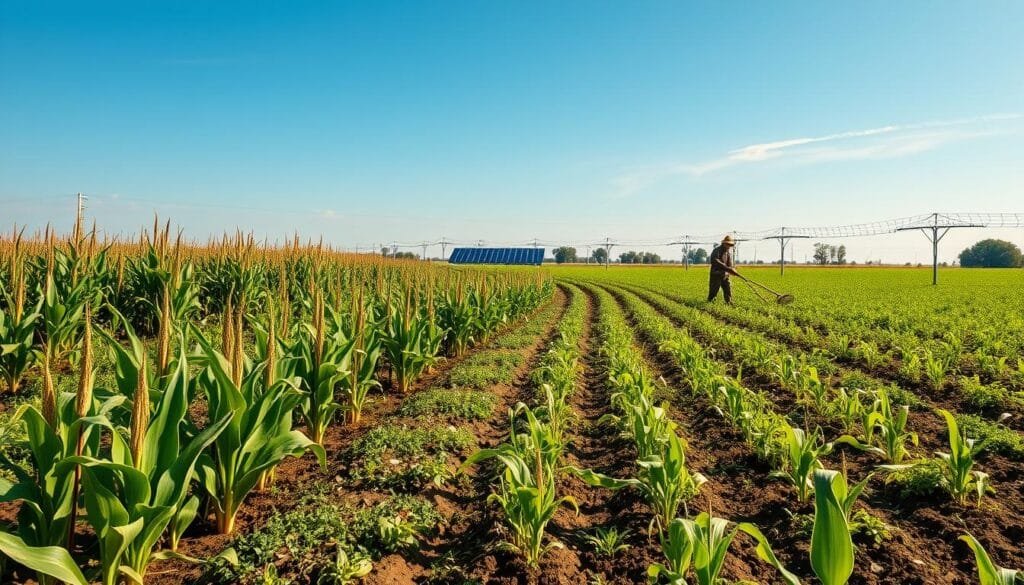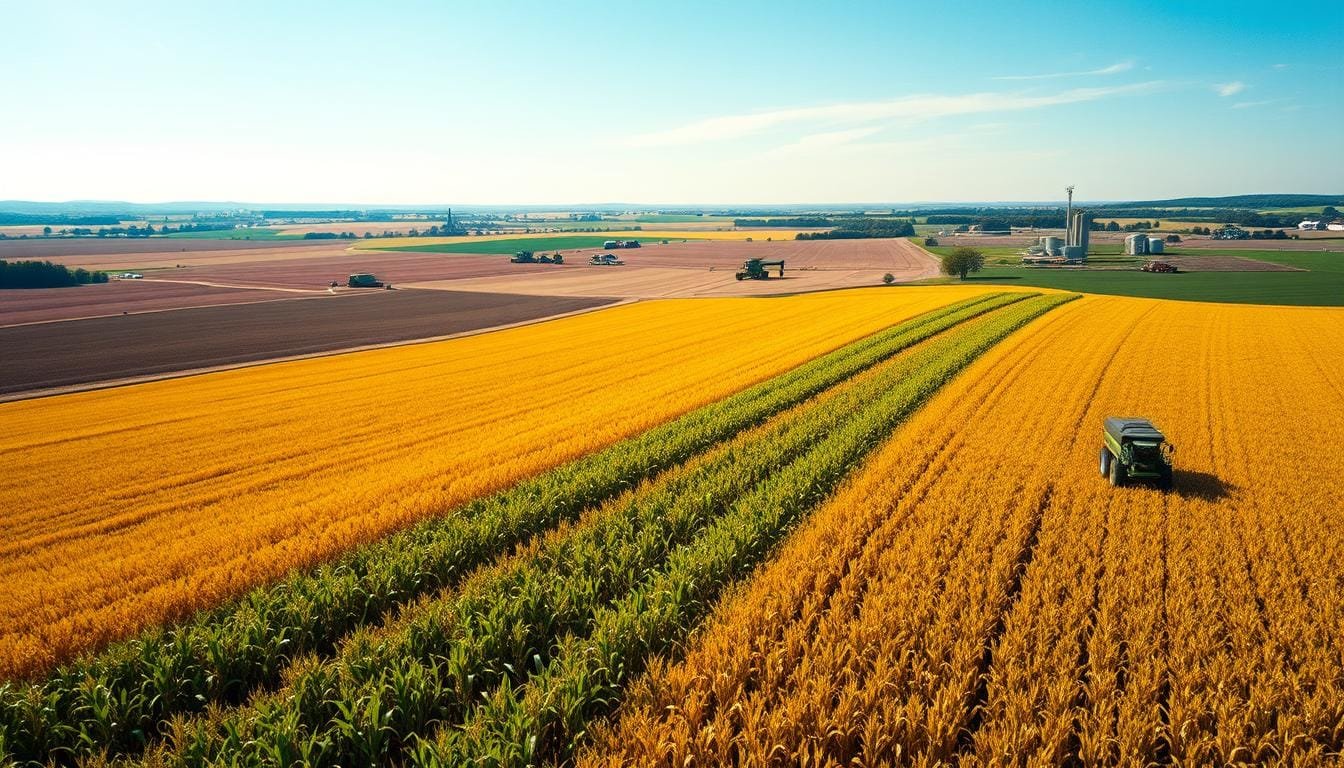In the world of agricultural economics, corn stands out for its major role in the global food supply. It’s not just a food staple but also a key raw material. This shows the power of modern farming. The United States leads in growing corn. It helps feed many people around the world.
As we look into corn’s uses, we find it’s important in many areas. It goes beyond just food, like corn oil, to things like eco-friendly packaging. Corn sweeteners make up over half of the U.S. sweetener market. This shows how much our diets rely on corn. Corn plays a big part in both world trade and ensuring everyone has enough to eat.
Key Takeaways
- Navigating agricultural economics encompasses understanding corn’s multi-faceted role.
- The global reliance on corn as a primary cereal crop significance is evident in both consumption and industrial use.
- The U.S. farming sector emphasizes the global food supply chain’s dependency on high-yield crops like corn.
- Statistics exhibit corn’s dominance, with a single ear boasting 800 kernels and a U.S. farmer nourishing 129 people worldwide.
- Employing over half of Iowa’s corn produce for foreign markets, the U.S. remains a steadfast contributor to the international market.
- Environmental considerations, particularly soil nutrient management, are critical in the sustainable production of corn for food and biofuel.
- Research from the University of Illinois at Urbana-Champaign offers insights into the economic vs. environmental trade-offs in corn production.
Overview of Corn’s Global Influence
The global corn market plays a big role in agriculture. It’s important to see how corn affects economies and industries. We see its value in food, industry, and much more.
Corn Production Statistics
In the United States, the leading country for corn, there are 91.7 million acres of cornfields. In 2023, these fields produced 15.3 billion bushels. This brought in $73.9 billion and supported over 600,000 jobs.
Corn’s Role in Human Consumption
Corn is a key part of our food. It’s in thousands of products and makes up 40% of animal feed. Ethanol, made from corn, provides 10% of U.S. fuel, showing corn’s energy value.
Industrial and Alternative Uses of Corn
Corn is also used in making bioplastics, adhesives, and eco-friendly packaging. Ethanol from corn cuts carbon emissions by 25%. This highlights corn’s role in better manufacturing and energy.
| Category | Economic Output ($) | Jobs Supported | Specific Contributions |
|---|---|---|---|
| Total Economic Impact | 151 Billion | 600,000 | Cross-sector economic infusion |
| Direct Farming Income | 73.9 Billion | Data Not Specific | Value from 15.3 billion bushels |
| Related Industries | 62 Billion | 500+ sectors | Feed, fuel, and industrial uses |
In summary, the global corn market does more than just feed us. It’s a huge part of the economy. It supports jobs and helps industries grow, making corn very important.
What is the economic importance of corn
Corn is more than just a crop in the world of agriculture; it’s a key part of our economy and food safety. This economic significance of corn reaches far beyond local farms. It impacts international markets, showing its crucial role in supporting countries’ economies and global food networks.
Contribution to National Economies
The value of corn is clear in national economies, especially in the U.S. Take Minnesota, for example. Here, corn farmers contributed 9.7 percent of the U.S.’s total corn sales value in 2023. This was about $7.2 billion. This huge production supported 47,461 jobs and brought in $2.65 billion in wages just in Minnesota. Across the U.S., corn farming’s economic impact was immense in 2023. It produced about $151 billion in economic output and added $62 billion to the GDP.
This production has a big impact beyond just these numbers. It supports over 600,000 jobs across the U.S. These jobs paid out around $35 billion in wages in 2023.
| State | Corn Production Value (2023) | Jobs Supported | Total Wages |
|---|---|---|---|
| Minnesota | $7.2 billion | 47,461 | $2.65 billion |
| Total U.S. | $73.9 billion | 600,000+ | $35 billion |
Impact on Food Security
Corn boosts food security by being widely available and versatile. It’s key as a staple food in various forms, like grits and sweeteners. Its ability to grow in many climates and soils, plus its low cost, make it a reliable global food source.
Its use feeds not only people but also livestock and is used in making ethanol. This diverse use of corn ensures a strong food supply chain and enhances food security.

The economic significance of corn clearly benefits our economies and food security. It plays a huge role in our lives and the world economy.
Economic Benefits of Corn in the Agricultural Sector

Corn is a key player in agriculture, feeding lots of livestock and aiding in renewable energy. Its role in bioenergy shows the agricultural impact of corn. It’s crucial for modern farming and energy.
Corn’s Impact on Livestock Feeding
Corn is vital for many farm animals’ diets. It’s used as grain or silage, offering much-needed energy. This meets the primary energy needs for animals, boosting growth and output.
The Role of Corn in Biofuel Production
Corn also becomes ethanol for renewable fuel, showing its versatility. More than a third of U.S. corn goes to ethanol, making it key for biofuel and environmental goals.
Corn has two main uses: feeding animals and making renewable energy. It stands out in both agriculture and ecology. Corn is essential for supporting both food and energy.
Corn as a Key Export Commodity
Corn plays a huge role in the U.S. economy. As a top seller on the global market, it improves the U.S. trade balance. The United States is known worldwide for its quality corn. This corn is turned into many products, like cereals, alcohol, and sweeteners. These products greatly help the country’s trade surpluses.
Leading Importers of U.S. Corn
The U.S. stands strong in the world thanks to ties with countries that need our corn. Mexico is the top buyer, loving our corn for its starch. Also, Colombia’s increase in buying U.S. agricultural products shows they rely on our corn. This corn is vital for their food and industry needs.
Effects on Trade Balances
Exporting corn is key for the U.S. in trade. It helps keep the trade balance healthy, with demand expected to rise. This helps U.S. farmers and makes the global food supply more stable.
Studying the effects of corn exports on trade balances gives insights into economic policies. The relationship among corn trading countries highlights the need for ongoing, dedicated partnership cultivation.
| Country | Import Volume (Metric Tons) | Year |
|---|---|---|
| Mexico | 10,000,000 | 2022 |
| Japan | 8,500,000 | 2022 |
| South Korea | 3,400,000 | 2022 |
| Colombia | 4,200,000 | 2022 |
Sustainable Corn Farming Practices
In our journey towards sustainable agriculture, understanding the balance between economic gains and environmental impacts is key. Corn plays a crucial role as a staple crop. By adopting sustainable agriculture principles, we support ecosystems and boost farming communities’ profitability and resilience.
Organic vs. GM Corn Production
The debate between genetically modified crops and organic corn is central to agricultural talks. GM corn, worth about $4.5 billion, boasts of higher yields and pest resistance. Meanwhile, organic corn attracts higher prices for its non-GM status, appealing to those preferring natural options.
A recent survey of nearly 1,800 conventional corn growers in 19 states showed varied adoption of sustainable methods. Half of the farms scored between 50 and 75 on sustainability, highlighting a chance to improve. This could increase the market scope for both GM and organic corn.
Economic and Environmental Trade-offs
Shifting to sustainable practices brings clear economic benefits. Farmers using eco-friendly techniques generally earn more. This results from higher yields and less variability, thanks to practices like natural pesticides and crop rotation.
Our data reveals an economic incentive: improving sustainability can boost income. Going from an average sustainability score to the top 10% raises income by 2.3%. This comes from better productivity and reduced costs related to pests and chemicals.
Environmental benefits are just as important. For example, cover crops enrich soil and help control weeds, reducing the need for chemical herbicides.
| Key Variable | Impact on Sustainability | Economic Benefit |
|---|---|---|
| Cover Crops | Improves soil health, increases biodiversity | Reduces costs from pest and weed control |
| Natural Pesticides | Decreases environmental toxicity | Enhances marketability for organic markets |
| Proper Crop Rotation | Prevents soil degradation | Increases yield stability over years |

Sustainable corn farming depends on balancing innovative farming techniques with ecological care. It’s our duty to both present and future generations, ensuring our agricultural land remains healthy and productive.
Conclusion
Throughout our study of corn’s economic importance, we’ve seen its vital roles. They include being a key food source, a crucial part of animal feed, a major player in renewable energy, and a significant part of global trade. Corn’s impact is huge, with every dollar in the sweet corn industry leading to more financial activity. The employment and income statistics show how this sector boosts the economy and helps society.
Wisconsin plays a key role in corn farming, holding a 37 percent share in U.S. sweet corn exports in 2011. This brought in almost $130 million and created many jobs. Looking at details, such as profits from different corn farming methods, shows that smart farming can bring big economic benefits. The numbers, covering everything from profits per acre to tax benefits, show how important corn is to America’s agricultural landscape.
To keep corn as a cornerstone of our economy, we need to back policies that focus on money and the environment. These policies must encourage new ways to farm sustainably, increase food security, and help farmers. By learning from successful farming practices across the country, we can grow corn in ways that meet our needs and protect the land for future generations. It’s up to all of us to make sure corn continues to bring wealth in an eco-friendly way.
FAQ
What makes corn significant in the context of agricultural economics?
Corn is key in agricultural economics for many reasons. It is a main food crop and livestock feed. It also plays a big role in the global food supply and renewable energy, via biofuels. This makes corn a vital part of the ag sector and impacts a country’s economy greatly.
How does corn cultivation affect the global corn market?
The way we grow corn shapes the worldwide corn market. The U.S. is a top producer, influencing prices and trade. The large number of corn products also shows the crop’s big influence on the market.
In what ways is corn fundamental to human consumption?
Corn is very important for our diets. It gives us carbs, protein, and fiber. Corn shows up in our meals as cornmeal, oil, and syrup. It’s a big part of our diet and leads in the sweetener market.
Can you describe the industrial and alternative uses of corn?
Corn has many uses beyond just food. It’s used in making things like drywall and glue. It’s key for producing ethanol, a clean fuel. This shows corn’s versatility and its value to the economy.
Why is corn’s contribution to national economies so crucial?
Corn’s impact goes beyond just agriculture. It helps industries like livestock feed, fiber, and ethanol. This makes economies stronger and more diverse. It also drives growth and helps ensure we have enough food.
How does corn impact food security globally?
Corn helps with food security by being a cheap and flexible food option. It grows in different environments, meeting nutritional needs. This helps fight hunger and malnutrition.
What role does corn play in livestock feeding?
Corn is crucial for feeding animals. It’s a main carbohydrate source in their diet. It’s used as silage for cows and as feed for cattle, hogs, and poultry. This supports meat, egg, and dairy production.
How significant is corn in biofuel production?
Corn is key in making biofuel, notably ethanol. This supports renewable fuel goals and cuts fossil fuel use. It’s important for the energy sector and offers a green energy solution.
Which countries are the leading importers of U.S. corn, and why?
Countries like Mexico, South Korea, Japan, and Colombia buy a lot of U.S. corn. They trust its quality, which helps their food security and industries. This also helps the U.S. economy through trade.
What effects does corn trading have on trade balances?
Trading corn can help a country’s trade balance by bringing in export money. As a top export, corn helps improve the trade outlook for countries like the U.S. It boosts their ag sector’s success.
How do organic and GM corn production differ economically and environmentally?
GM corn is more efficient, so it’s worth more on the market. But, organic corn gets higher prices due to its special market. Environmentally, GM corn may harm biodiversity, while organic corn is seen as greener but yields less.
What are the economic and environmental trade-offs associated with sustainable corn farming?
Sustainable corn farming tries to balance making money with caring for the planet. It thinks about the effects of GM corn’s high yields against the environmental goods and market value of organic corn.
